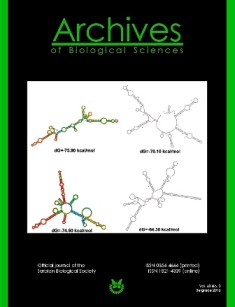Genetic diversity analysis based on molecular marker and quantitative traits of the response of different tomato (Lycopersicon esculentum Mill.) cultivars to drought stress
Abstract
The drought tolerance of tomato (Lycopersicon esculentum Mill.) is a trait needing urgent improvement due to recent climate changes and limited water availability. We therefore conducted a greenhouse screening experiment to identify tomato cultivars with improved drought tolerance. Several sensitivity and tolerance indices were computed based on morphological markers. With the aim of establishing a correlation to these markers, a total of 16 inter-simple sequence repeat (ISSR) primers were used, the genetic diversity among cultivars was elucidated and clustering the cultivars into groups based on their molecular profiles was performed. The obtained results indicated that selection indices, such as geometric mean productivity (GMP), mean productivity (MP), tolerance index (TOL),and stress tolerance index (STI), represented suitable indices for screening the drought tolerance of tomato cultivars. An interesting correlation of the ISSR analyses to these morphological findings was established according to 83 detectable fragments derived from 10 primers. The highest value of the effective multiplex ratio (EMR) and marker index (MI) was detected for primer INC7 followed by INC1. Based on Jaccard's similarity coefficients, the genetic distance of the genotypes varied from 0.702 to 0.942 with a mean value of 0.882. The results showed a clear-cut separation of the 15 tomato cultivars due to their genetic variability, making them a valuable genetic source for their incorporation into potential breeding programs. Molecular data were in good agreement with the results as regards selection indices, and both will be useful tools for improvement of the tomato germplasm.Downloads
Download data is not yet available.
Downloads
Published
2016-06-27
How to Cite
1.
Metwali EM, Carle R, Schweiggert RM, Kadasa NM, Almaghrabi OA. Genetic diversity analysis based on molecular marker and quantitative traits of the response of different tomato (Lycopersicon esculentum Mill.) cultivars to drought stress. Arch Biol Sci [Internet]. 2016Jun.27 [cited 2026Jan.7];68(2):427-38. Available from: https://www.serbiosoc.org.rs/arch/index.php/abs/article/view/785
Issue
Section
Articles
License
Authors grant the journal right of first publication with the work simultaneously licensed under a Creative Commons Attribution 4.0 International License that allows others to share the work with an acknowledgment of the work’s authorship and initial publication in this journal.




